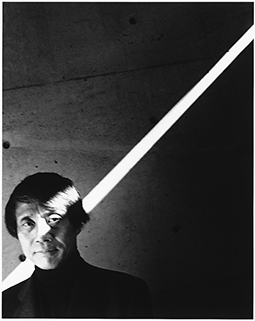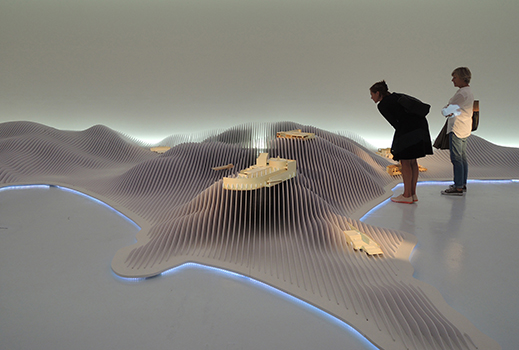 |
Focus features two in-depth reviews each month of fine art, architecture and design exhibitions and events at art museums, galleries and alternative spaces around Japan. The contributors are non-Japanese residents of Japan. |
|
|
 |
 |
 |
Tadao Ando: An Architect's Search for New Discoveries
James Lambiasi |
 |
One of the most prolific Japanese architects today, Tadao Ando has designed numerous buildings, each with a uniqueness befitting his very unconventional career. Born in Osaka and originally a professional boxer, Ando was exposed to none of the influences that form the intellectual foundation of so many of his contemporaries in Japan. He trained himself as an architect, and subsequently established Tadao Ando Architect & Associates in 1969. Today he is globally recognized as one of the most influential architects of his time.
|
 |
|
|
|
Portrait of Tadao Ando.
Photo by Nobuyoshi Araki
|
To celebrate the tenth anniversary of the National Art Center, Tokyo, the current exhibition entitled TADAO ANDO: ENDEAVORS focuses on the incredible life and works of Japan's premier architect. Equally as prolific as the volume of Ando's work, the exhibition is an ambitious collection of buildings from throughout his entire career. In addition to 270 models, sketches, and drawings, highlights include a full-scale replica of his grand office space, places to immerse oneself in exhibits of his evolving projects on Naoshima Island, and a full-scale replica of his iconic Church of the Light.
As in any good book, the narrative of each chapter in Ando's fascinating career must introduce the essential elements of his work. The exhibition conveys these ideas by presenting the works in six separate sections: "Origins/Houses," "Light," "Void Spaces," "Reading the Site," "Building Upon What Exists, Creating That Which Does Not Exist," and "Nurturing."
Taking a look back to the origins of Ando's residential design reveals elements that remain important to his work. Completed in 1976, Row House in Sumiyoshi exemplifies Ando's defensive "guerrilla architect" attitude toward the often harsh conditions of an industrial city like Osaka. A windowless and unfinished concrete façade blocks out any interaction with the city, while the pure elements of light and air are accessed by a pristine courtyard that completely cuts the four-room dwelling into separate spaces. This combination of sensitivity toward nature with a layout that boldly required the client to brave the elements when leaving each room created a shocking environment that quickly elevated him onto the world stage.
 |
|
Row House in Sumiyoshi (1976), Osaka.
Photo by Shinkenchiku-sha |
Model of Row House in Sumiyoshi. |
Especially in his early works, concrete has been an indispensable material employed by Ando to highlight an even more important material: light. To conventional eyes a wall of unfinished concrete might suggest a stark, heavy-handed aesthetic, but for Ando the raw concrete represents a blank canvas to showcase the beauty of light. Elements such as windows and doors transcend their utilitarian roles, instead functioning as openings that allow light to enter and sculpt rich spatial experiences. This is abundantly evident in his Church of the Light, which uses cross-configured slits in the walls to illuminate the space. This can be experienced firsthand through the full-size reconstruction of the nave of the church as part of the exhibition. His Church on the Water conversely eliminates an entire wall to have the floor flow outward and transform into subtly stepping sheets of water.
Church of the Light (1989), Ibaraki, Osaka.
Photo by Mitsuo Matsuoka |
Church on the Water (1988), Yufutsu-gun, Hokkaido.
Photo by Yoshio Shiratori |
Indeed, another material equally important to Ando's structures is something immaterial: "void spaces." Many might interpret the spaces and voids in a typical Ando building as minimal at best, perhaps starkly vacant. Just as the most minimal of materials, such as raw concrete, accentuate subtle perceptions of light, the absence of program in his spaces serves to foreground the movement and presence of air, sound, and human interactions. The Shanghai Poly Grand Theater, for example, shows how a deep void carved out of the building volume creates a rich space that envelops visitors traversing a floating bridge.
Shanghai Poly Grand Theater (2014), Shanghai, China.
Photo by Shigeo Ogawa |
At the scale of the building, Ando deftly displays his ability to incorporate nature into his architecture. Taking this one step further, he has also demonstrated that on a much larger scale the building itself must defer to its surroundings in order to respectfully integrate with the site. The section of the exhibition titled "Reading the Site" features large-scale models of Ando's projects on Naoshima, an island in the Seto Inland Sea. Spanning three decades, he has realized seven projects that have slowly and subtly evolved and integrated with the natural landscape of the island. Just as the unfinished concrete showcased sunlight in his original house designs, the bold and very distinguishing geometric forms of his buildings actually heighten one's awareness of the organic green lushness of the host site. This is evident in Benesse House Oval, in which Ando isolates a pristine oval of space with a rooftop of greenery. Thinking back to his earlier work, such as Row House in Sumiyoshi, one might recall the same vocabulary in which he boldly gives form to a space but consistently invites a dialogue with light, air, and human activity to bring it to life. These two projects are worlds apart in scale, budget, and time -- yet this opportunity to see them together in one exhibition certainly sums up the values that Ando has endeavored to achieve in his architecture. TADAO ANDO: ENDEAVORS will be on exhibit until 18 December 2017.
 |
|
Model of Naoshima Project, Naoshima, Kagawa. |
Benesse House (1992/1995), Naoshima, Kagawa.
Photo by Mitsuo Matsuoka |
All images courtesy of the National Art Center, Tokyo.
|
 |
 |
James Lambiasi
Following completion of his Master's Degree in Architecture from Harvard University Graduate School of Design in 1995, James Lambiasi has been a practicing architect and educator in Tokyo for over 20 years. He is the principal of his own firm James Lambiasi Architect, has taught as a visiting lecturer at several Tokyo universities, and has lectured extensively on his work. James served as president of the AIA Japan Chapter in 2008 and is currently the director of the AIA Japan lecture series that serves the English-speaking architectural community in Tokyo. He blogs about architecture at tokyo-architect.com. |
|
 |
|